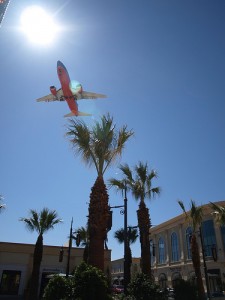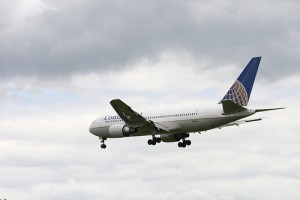
Southwest Airlines flight leaving from Las Vegas, NV
A passenger getting naked on a plane is almost becoming old news. However, I am not tired of blogging about them, so I shall continue. This week’s nudity is brought to you by a Las Vegas bound guy and was found on the Airline Biz Blog.
Southwest Airlines flight 943 left from Oakland and was heading towards Las Vegas when a male passenger exposed himself to a female passenger. That wasn’t enough for him so he decided to hit another female passenger. This was enough for the people aboard and he was restrained.
The crazy man decided this would be a good time to get completely naked and rowdy. Passengers and crew became more aggressive in their restraining and the pilot decided to return the plane back to Oakland.
Image: gTarded

Continental Boeing 767-200 much like the one involved in this incident.
Continental airlines flight 128 from Brazil to Texas hit a bad patch of turbulence, injuring over 30 passengers. The Boeing 767 was about six hours into its flight when all of a sudden the aircraft lost altitude. Passenger Fabio Ottolini stated, “People didn’t have time to do anything.” He stated that flight attendants were in the middle of service when the incident occurred, causing some to hit the ceiling. The aircraft landed in Miami where 13 people were taken to local hospitals and four were seriously injured.
This is reminder that everyone should keep their seatbelts on while in flight. Yes, it is very tempting to take the belt off, but it is never worth the risk. The Science Christian Monitor reports that from 1980 to June 2004, airlines in the United States had 198 turbulence accidents, resulting in 266 serious injuries and three fatalities. The three fatalities resulted in passengers not wearing their seatbelt, while the fasten seatbelt sign was illuminated.
For updates on this story, check out Ben Mutzabaugh’s blog, Today in the Sky.
Image: sohvimus

- AmSafe’s aviation airbag
Most of the major airline crashes in the last year have ended in no survivors. When an aircraft drops out of the sky or has a huge catastrophe, no safety feature would prevent fatalities. However, there are many crash scenarios where some additional safety features could help to save lives.
When an accident happens on the ground (while taxiing, take off, landing, etc), in most cases passengers survive. However, in some cases, the cabins can be overcome by fire or smoke before passengers can escape.
Most aircraft today have “16g” seats. This means the seat has to be able to withstand 16 times the force of gravity (16 times the force of gravity is about equal to going from 30mph to 0mph instantly). Creating a seat to withstand more than 16g’s wouldn’t make sense, since any force greater than that would not be survivable.
Newer seats are not the only measures in place to keep passengers safe. Taking a page from the auto industry, some airlines have added airbags to seats and other surfaces. To make sure the airbags would not go off due to turbulence or a rough landing, the sensor only looks at the axis the plane is traveling for sudden stops, much like in an automobile. The goal is like that of stronger seats – get passengers out of a wrecked aircraft. ’œYou’re going to be conscious. You’re going to have the opportunity to survive,’ said Bill Hagan, president of AmSafe, which makes the airbags.
Airbags are currently installed in First and Business class seats where they are too far from the seat in front to offer protection. They are also starting to be seen on bulkhead, exit, lavatory, and galley rows.
USAToday asks – do all these extra safety features mean extra weight, and therefore more costs to the passenger? It possibly could, but wouldn’t it be worth the costs? Airlines often upgrade their safety equipment and sometimes the costs are handed down the customer. I know I would be willing to pay a few extra bucks to better the chance of my survival and of those around me if I were to be put in a disastrous airline situation.

Garuda Indonesia, Airbus A330, PK-GPA departing JFK, New York, USA. Sept 2007
After a series of accidents, the European Union (EU) banned all flights based in Indonesia in June 2007. Garuda Airlines, Airfast Indonesia, Mandala Airlines and Premiair were all taken off the ban list recently and will have the right to fly in EU airspace. The European Commission, who removed the ban, stated “significant improvements and accomplishments of the Indonesian civil aviation authority are recognized in the area of safety”.
EU Transport Commissioner, Antonio Tajani is hoping this (and the recent Yemenia Airlines crash) will renew the debate with having international blacklist of airlines felt to be unsafe.
With airlines from the around the world having different safety regulations, having some formal and easy way to rate the safest and least-safe airlines would be beneficial, but maybe not possible. Who would police the list? Who would determine the criteria? Could one country or organization step up to create a list that the flying public could reference when choosing an airline?
Image: Tom Turner

Thomas Cook Boeing 757
You hear the stories of a doctor or law enforcement officer on a flight stepping forward to help out on a plane, but this time an engineer had his day in the spotlight.
Passengers on Thomas Cook flight TCX9641 from Menorca, Spain were told their flight would be delayed eight hours while an engineer was flown in to work on the plane. One passenger felt he might be of service and identified himself as a qualified aircraft engineer. After careful scrutiny, it was determined the man was highly qualified to work on the Boeing 757-200, as he actually works for a company that has a reciprocal maintenance agreement with Thomas Cook.
The man was able to determine the issue and fix it rather quickly. When re-boarding the aircraft, he was greeted with a big round of applause. The flight was able to take off and arrive only 35 minutes late to Glasglow, UK.
Thanks Dr. Forbes for the Tip!
Source: BBC Image: fishbed93




